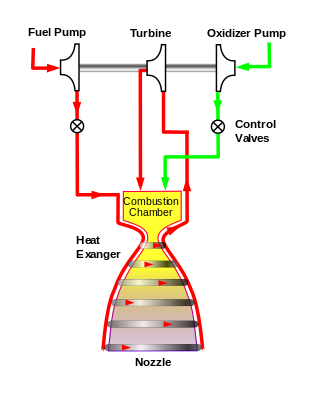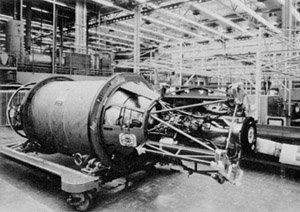
A hybrid-propellant rocket is a rocket with a rocket motor that uses rocket propellants in two different phases: one solid and the other either gas or liquid. The hybrid rocket concept can be traced back to the early 1930s.

The expander cycle is a power cycle of a bipropellant rocket engine. In this cycle, the fuel is used to cool the engine's combustion chamber, picking up heat and changing phase. The now heated and gaseous fuel then powers the turbine that drives the engine's fuel and oxidizer pumps before being injected into the combustion chamber and burned.

A liquid-propellant rocket or liquid rocket utilizes a rocket engine burning liquid propellants. (Alternate approaches use gaseous or solid propellants.) Liquids are desirable propellants because they have reasonably high density and their combustion products have high specific impulse (Isp). This allows the volume of the propellant tanks to be relatively low.

The Aerojet Rocketdyne RS-25, also known as the Space Shuttle Main Engine (SSME), is a liquid-fuel cryogenic rocket engine that was used on NASA's Space Shuttle and is used on the Space Launch System (SLS).

The F-1, commonly known as Rocketdyne F-1, is a rocket engine developed by Rocketdyne. The engine uses a gas-generator cycle developed in the United States in the late 1950s and was used in the Saturn V rocket in the 1960s and early 1970s. Five F-1 engines were used in the S-IC first stage of each Saturn V, which served as the main launch vehicle of the Apollo program. The F-1 remains the most powerful single combustion chamber liquid-propellant rocket engine ever developed.

The J-2, commonly known as Rocketdyne J-2, was a liquid-fuel cryogenic rocket engine used on NASA's Saturn IB and Saturn V launch vehicles. Built in the United States by Rocketdyne, the J-2 burned cryogenic liquid hydrogen (LH2) and liquid oxygen (LOX) propellants, with each engine producing 1,033.1 kN (232,250 lbf) of thrust in vacuum. The engine's preliminary design dates back to recommendations of the 1959 Silverstein Committee. Rocketdyne won approval to develop the J-2 in June 1960 and the first flight, AS-201, occurred on 26 February 1966. The J-2 underwent several minor upgrades over its operational history to improve the engine's performance, with two major upgrade programs, the de Laval nozzle-type J-2S and aerospike-type J-2T, which were cancelled after the conclusion of the Apollo program.

The Rocketdyne H-1 was a 205,000 lbf (910 kN) thrust liquid-propellant rocket engine burning LOX and RP-1. The H-1 was developed for use in the S-I and S-IB first stages of the Saturn I and Saturn IB rockets, respectively, where it was used in clusters of eight engines. After the Apollo program, surplus H-1 engines were rebranded and reworked as the Rocketdyne RS-27 engine with first usage on the Delta 2000 series in 1974. RS-27 engines continued to be used up until 1992 when the first version of the Delta II, Delta 6000, was retired. The RS-27A variant, boasting slightly upgraded performance, was also used on the later Delta II and Delta III rockets, with the former flying until 2018.

Merlin is a family of rocket engines developed by SpaceX for use on its Falcon 1, Falcon 9 and Falcon Heavy launch vehicles. Merlin engines use RP-1 and liquid oxygen as rocket propellants in a gas-generator power cycle. The Merlin engine was originally designed for sea recovery and reuse, but since 2016 the entire Falcon 9 booster is recovered for reuse by landing vertically on a landing pad using one of its nine Merlin engines.

The staged combustion cycle is a power cycle of a bipropellant rocket engine. In the staged combustion cycle, propellant flows through multiple combustion chambers, and is thus combusted in stages. The main advantage relative to other rocket engine power cycles is high fuel efficiency, measured through specific impulse, while its main disadvantage is engineering complexity.

The gas-generator cycle, also called open cycle, is one of the most commonly used power cycles in bipropellant liquid rocket engines. Part of the unburned propellant is burned in a gas generator and the resulting hot gas is used to power the propellant pumps before being exhausted overboard, and lost. Because of this loss, this type of engine is termed open cycle.

The NK-33 and NK-43 are rocket engines designed and built in the late 1960s and early 1970s by the Kuznetsov Design Bureau. The NK designation is derived from the initials of chief designer Nikolay Kuznetsov. The NK-33 was among the most powerful LOX/RP-1 rocket engines when it was built, with a high specific impulse and low structural mass. They were intended for the ill-fated Soviet N1F Moon rocket, which was an upgraded version of the N1. The NK-33A rocket engine is now used on the first stage of the Soyuz-2-1v launch vehicle. When the supply of the NK-33 engines are exhausted, Russia will supply the new RD-193 rocket engine. It used to be the first stage engines of the Antares 100 rocket series, although those engines are rebranded the AJ-26 and the newer Antares 200 and Antares 200+ rocket series uses the RD-181 for the first stage engines, which is a modified RD-191, but shares some properties like a single combustion chamber unlike the two combustion chambers used in the RD-180 of the Atlas V and the four combustion chambers used in the RD-170 of the Energia and Zenit rocket families, and the RD-107, RD-108, RD-117, and RD-118 rocket engines used on all of the variants of the Soyuz rocket.
The RD-8 is a Soviet / Ukrainian liquid propellant rocket engine burning LOX and RG-1 in an oxidizer rich staged combustion cycle. It has a four combustion chambers that provide thrust vector control by gimbaling each of the nozzles in a single axis ±33°. It was designed in Dnipropetrovsk by the Yuzhnoye Design Bureau as the vernier thruster of the Zenit second stage. As such, it has always been paired with the RD-120 engine for main propulsion.

The Aerojet M-1 was one of the largest and most powerful liquid-hydrogen-fueled liquid-fuel rocket engine to be designed and component-tested. It was originally developed during the 1950s by the US Air Force. The M-1 offered a baseline thrust of 6.67 MN and an immediate growth target of 8 MN. If built, the M-1 would have been larger and more efficient than the famed F-1 that powered the first stage of the Saturn V rocket to the Moon.

The LE-5 liquid rocket engine and its derivative models were developed in Japan to meet the need for an upper stage propulsion system for the H-I and H-II series of launch vehicles. It is a bipropellant design, using LH2 and LOX. Primary design and production work was carried out by Mitsubishi Heavy Industries. In terms of liquid rockets, it is a fairly small engine, both in size and thrust output, being in the 89 kN (20,000 lbf) and the more recent models the 130 kN (30,000 lbf) thrust class. The motor is capable of multiple restarts, due to a spark ignition system as opposed to the single use pyrotechnic or hypergolic igniters commonly used on some contemporary engines. Though rated for up to 16 starts and 40+ minutes of firing time, on the H-II the engine is considered expendable, being used for one flight and jettisoned. It is sometimes started only once for a nine-minute burn, but in missions to GTO the engine is often fired a second time to inject the payload into the higher orbit after a temporary low Earth orbit has been established.

The pintle injector is a type of propellant injector for a bipropellant rocket engine. Like any other injector, its purpose is to ensure appropriate flow rate and intermixing of the propellants as they are forcibly injected under high pressure into the combustion chamber, so that an efficient and controlled combustion process can happen.

The TR-106 or low-cost pintle engine (LCPE) was a developmental rocket engine designed by TRW under the Space Launch Initiative to reduce the cost of launch services and space flight. Operating on LOX/LH2 the engine had a thrust of 2892 kN, or 650,000 pounds, making it one of the most powerful engines ever constructed.

Since the founding of SpaceX in 2002, the company has developed four families of rocket engines — Merlin, Kestrel, Draco and SuperDraco — and is currently developing another rocket engine: Raptor, and after 2020, a new line of methalox thrusters.

The Bell Aerosystems Company XLR81 was an American liquid-propellant rocket engine, which was used on the Agena upper stage. It burned UDMH and RFNA fed by a turbopump in a fuel rich gas generator cycle. The turbopump had a single turbine with a gearbox to transmit power to the oxidizer and fuel pumps. The thrust chamber was all-aluminum, and regeneratively cooled by oxidizer flowing through gun-drilled passages in the combustion chamber and throat walls. The nozzle was a titanium radiatively cooled extension. The engine was mounted on a hydraulic actuated gimbal which enabled thrust vectoring to control pitch and yaw. Engine thrust and mixture ratio were controlled by cavitating flow venturis on the gas generator flow circuit. Engine start was achieved by solid propellant start cartridge.

Rutherford is a liquid-propellant rocket engine designed by aerospace company Rocket Lab and manufactured in Long Beach, California. The engine is used on the company's own rocket, Electron. It uses LOX and RP-1 as its propellants and is the first flight-ready engine to use the electric-pump feed cycle. The rocket uses a similar engine arrangement to the Falcon 9; a two-stage rocket using a cluster of nine identical engines on the first stage, and one vacuum-optimized version with a longer nozzle on the second stage. This arrangement is also known as an octaweb. The sea-level version produces 24.9 kN (5,600 lbf) of thrust and has a specific impulse of 311 s (3.05 km/s), while the vacuum optimized-version produces 25.8 kN (5,800 lbf) of thrust and has a specific impulse of 343 s (3.36 km/s).

Raptor is a family of rocket engines developed and manufactured by SpaceX. The engine is a full-flow staged combustion cycle (FFSC) engine powered by cryogenic liquid methane and liquid oxygen ("methalox").




















